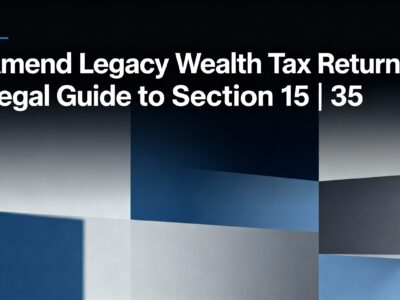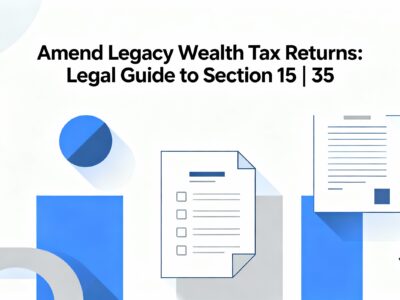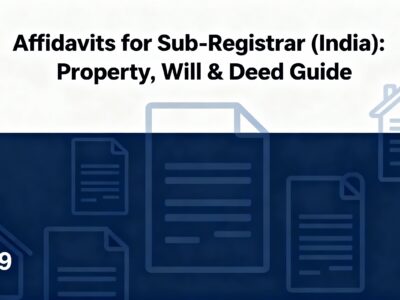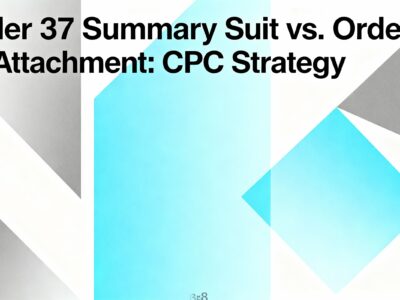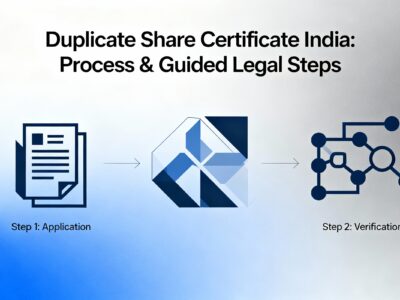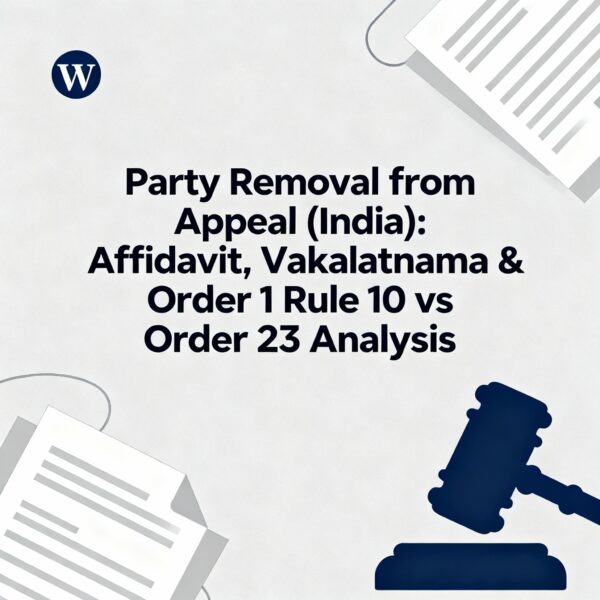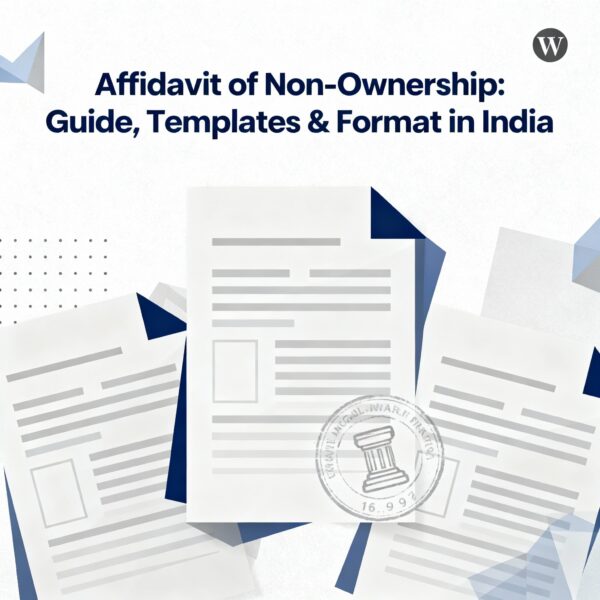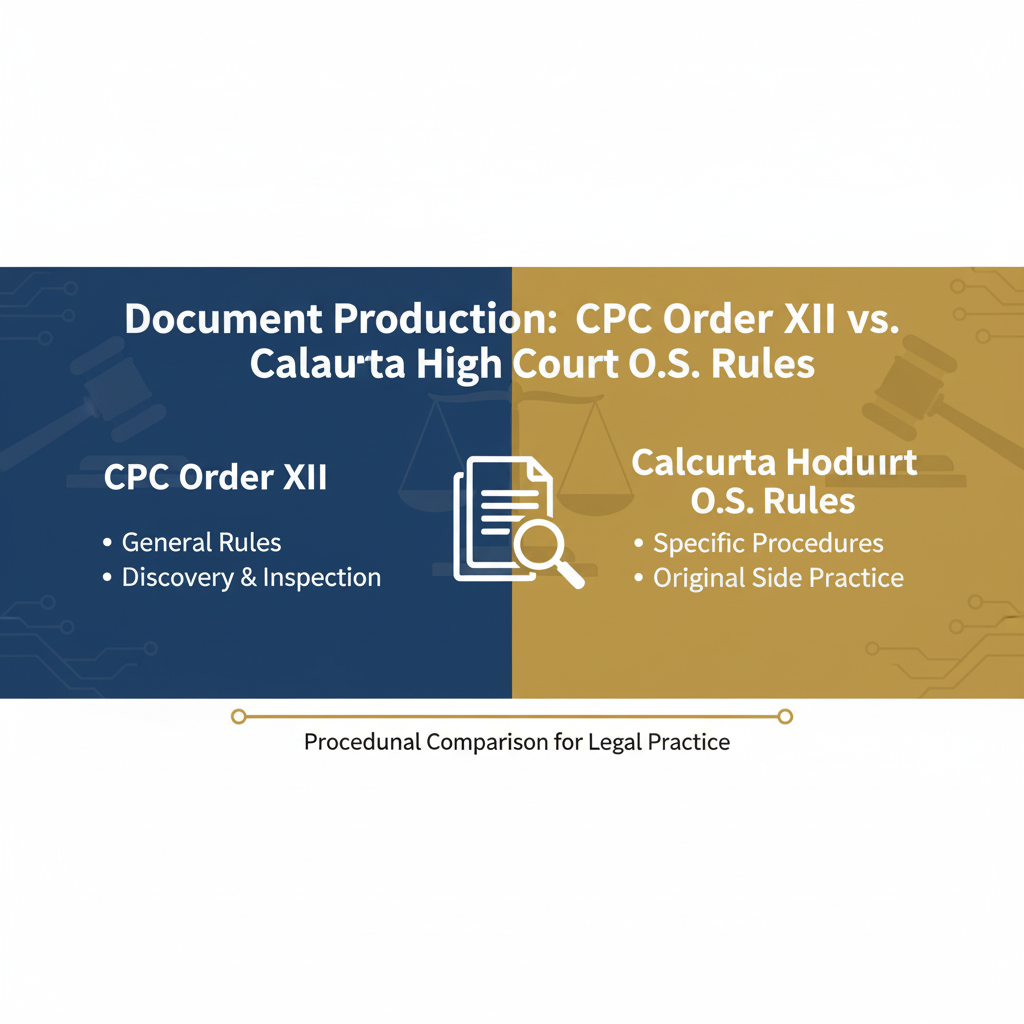Having an application or petition “dismissed for default” can be a major setback. The immediate challenge is knowing the correct procedure to revive it. Many mistakenly turn to Order IX, Rule 9, only to have their application dismissed as non-maintainable.
The correct path for restoring a miscellaneous application or petition lies in Section 151 CPC. This comprehensive guide breaks down the entire process, explaining the court’s “inherent power” and how to draft a compelling Affidavit for Restoration that establishes “sufficient cause.” We will cover legal strategy, common drafting pitfalls (especially the verification clause), and provide a master template to get you started.
The Affidavit for Restoration under Section 151 CPC
A Complete Guide to Drafting Formats and Legal Strategy
Last Updated: October 26, 2025
Quick Navigation:
Part 1: The Legal Foundation for Restoration
When an application is dismissed for non-appearance, the path to restoring it isn't always obvious. The power comes from Section 151 of the Code of Civil Procedure (CPC), 1908. This section doesn't *grant* new powers but saves the court's "inherent power" to make orders "for the ends of justice or to prevent abuse of the process of the Court."
A common and serious mistake is confusing this with Order IX, Rule 9. Understanding the difference is essential for your application to be maintainable.
Infographic: Two Paths to Restoration
This diagram shows the correct procedural path. Choosing the wrong one can lead to immediate dismissal of your restoration plea.
Comparative Analysis: Section 151 vs. Order IX, Rule 9
The distinction between these provisions is a fundamental point of jurisdiction. Filing under the wrong one is a fatal error. This table breaks down the differences.
| Feature | Order IX, Rule 9 CPC | Section 151 CPC |
|---|---|---|
| Applicable To | Suits dismissed for default. | Applications or Petitions (e.g., Misc. Applications, Execution Petitions) dismissed for default. |
| Legal Standard | Must prove "sufficient cause" for non-appearance. | Appeal to court's discretion, showing it's "necessary for the ends of justice." |
| Basis of Power | Specific Statutory Right. | Inherent Discretionary Power. Used only when no other specific remedy applies. |
| Limitation Period | 30 days from the date of dismissal (Article 122, Limitation Act). | No strict limitation, but governed by the Doctrine of Laches (undue delay is fatal). |
The Source Text: Section 151 CPC
This single section provides the entire foundation for your application. It is vital to understand its exact wording, which emphasizes justice and prevention of abuse.
"Nothing in this Code shall be deemed to limit or otherwise affect the inherent power of the Court to make such orders as may be necessary for the ends of justice or to prevent abuse of the process of the Court."
— Section 151, Code of Civil Procedure, 1908
Your application is a direct appeal to this inherent power. You are arguing that allowing the dismissal (based on a *bona fide* mistake) to stand would *not* be in the ends of justice.
Part 2: Establishing "Sufficient Cause"
To succeed, your affidavit must establish "sufficient cause" for the non-appearance. This term isn't defined in the code; it's left to the court's discretion. The core test is one of reasonableness: was the non-appearance avoidable with "due care and attention"?
Sufficient Cause: Do's and Don'ts
Grounds Often Accepted
- Sudden and serious illness of counsel or party.
- Involvement in an accident *en route* to court.
- A *bona fide* mistake by counsel's clerk about the hearing date.
- Failure of the court to serve proper notice of the hearing.
- Death of a close relative.
Grounds Often Rejected
- Gross or repeated negligence.
- A pattern of failing to appear or follow court orders.
- Simple carelessness by the party or their advocate.
- "Laches" – sitting on your rights and delaying the application after learning of the dismissal.
The Two-Document Combo: Petition vs. Affidavit
A restoration filing consists of two distinct documents filed together. Confusing their purpose is a common error. The "Petition" (or Application) makes the legal argument, while the "Affidavit" provides the sworn evidence.
- The Petition (Application): This is the formal request. It's written in the third person (e.g., "It is most respectfully showeth..."). It contains the prayer and the legal grounds (i.e., citing Section 151).
- The Affidavit: This is the sworn statement of facts supporting the petition. It's written in the first person ("I, ... do hereby solemnly affirm..."). This is where you narrate the "sufficient cause" (the illness, the accident, etc.).
Infographic: The Anatomy of Your Filing
This diagram shows how the two documents work together.
Part 3: Common (and Fatal) Drafting Pitfalls
Many restoration applications fail because of simple, avoidable errors in the affidavit. The most common is the jurisdictional contradiction: filing under S. 151 but referring to the dismissal of a "suit."
Infographic: Anatomy of a Flawed Affidavit
This diagram highlights two critical errors found in weak affidavits. An opposing counsel will spot these immediately.
The Verification Clause: The Cornerstone of Validity
The most poorly drafted part of most affidavits is the verification. Its purpose is to make the deponent responsible for the statements. A vague verification ("true to my knowledge and belief") is non-compliant with Order XIX, Rule 3 of the CPC.
The law requires you to be specific:
1. State which paragraphs are true to your personal knowledge.
2. State which paragraphs are based on information or belief.
3. For statements based on information, you must disclose the source (e.g., "from my counsel" or "from court records").
Infographic: "Slipshod" vs. "Master" Verification
A proper verification adds immense credibility and withstands legal challenges.
Case Study: Analyzing the Sample Affidavit
Let's deconstruct the specific scenario from the provided document: the party (deponent) is *present* in court, but their counsel is sick. The party requests a pass-over, but the court dismisses the application.
The Factual Narrative: A Strong Case
This is a very strong set of facts. The party's presence demonstrates diligence and a complete lack of negligence. The dismissal, in this context, could be argued as overly harsh, making it a perfect candidate for restoration under S. 151 to "secure the ends of justice."
Infographic: Anatomy of the Courtroom Event
Here is how you would structure this event in your affidavit narrative.
The Critical Flaw: The Verification Clause
The sample document, while factually strong, contains a legally weak verification:
"Verified at Delhi on this day of, ___ that the contents of my above affidavit are true and correct to the best of my knowledge and belief and nothing material has been concealed therefrom."
This is the classic "Slipshod" verification we discussed in Part 3. It fails to specify *which* paragraphs are true to personal knowledge (like being in court) and which are based on information (like the case number). An opposing counsel could attack this affidavit as being non-compliant with Order XIX, Rule 3.
Part 4: Annotated Master Template (S. 151 CPC)
Use this template as a starting point. It is designed to be legally sound, specific, and compliant with all procedural requirements. The annotations in yellow explain the purpose of each clause.
Disclaimer:
This is a sample template for informational purposes only and does not constitute legal advice. It must be adapted to the specific facts of your case.
Translation Disclaimer:
The following translations are provided for informational purposes only. They are not a substitute for professional legal translation. Always consult a qualified legal professional for official court filings in any language.
BEFORE THE HON'BLE COURT OF ____________, NEW DELHI MISCELLANEOUS APPLICATION NO. ____ OF 20__ Annotation: This is the NEW application number for the restoration itself. IN CIVIL MISCELLANEOUS PETITION NO. ___ OF 20__ Annotation: This is the application that was dismissed and you seek to restore. IN [APPEAL/SUIT] NO. ____ OF 20__ Annotation: This is the main parent case. IN THE MATTER OF: MR. _______________________ ... APPLICANT / PETITIONER VERSUS MR. _______________________ ... RESPONDENT / OPPOSITE PARTY AFFIDAVIT IN SUPPORT OF THE APPLICATION UNDER SECTION 151 OF THE CODE OF CIVIL PROCEDURE, 1908 I, _______________________, son of Shri. ________________, aged about __ years, resident of ______________________________, New Delhi-______, do hereby solemnly affirm and declare as under:- 1. That I am the Applicant in the application referred to above and as such, I am well acquainted with the facts and circumstances of the case and am competent to swear this affidavit. Annotation (Para 1): Establishes your standing (competence) and personal knowledge. 2. That the Applicant had filed the aforementioned Civil Miscellaneous Petition No. ___ of 20__ (hereinafter "the application") for [State the purpose, e.g., "seeking condonation of delay"]. Annotation (Para 2): Clearly identifies the *application* you want restored, not the 'suit'. 3. That the said application was listed for hearing before this Hon’ble Court on [Date of Dismissal]. This Hon'ble Court was pleased to dismiss the said application for default due to non-appearance on behalf of the Applicant. 4. That on the said date, i.e., [Date of Dismissal], the deponent's counsel, Shri. [Counsel's Name], was suddenly and unexpectedly struck by a severe illness, namely [Be specific, e.g., "acute viral fever and was advised complete bed rest"]. Consequently, he was absolutely unable to attend the Hon'ble Court. Annotation (Para 4): This is the "Sufficient Cause." Be specific, honest, and detailed. Attach evidence (like a medical certificate) as an Annexure if possible. 5. That the non-appearance on behalf of the Applicant on the said date was entirely due to the unforeseen and unavoidable circumstances detailed above, which were absolutely beyond the control of the deponent or his counsel. 6. That the non-appearance was entirely bona fide and was not owing to any default, neglect, or laches on the part of this deponent. Annotation (Para 6): This is a key legal plea. It directly negates the reasons a court would use to deny your application (negligence or delay). 7. That the deponent learned of the said dismissal order on [Date of Learning], and immediately contacted his counsel to take steps for restoration. This application is being filed at the earliest possible opportunity and without any undue delay. Annotation (Para 7): This defeats any "Doctrine of Laches" argument. It shows you acted diligently as soon as you found out. 8. That the Applicant has a strong *prima facie* case in the main application, and if the order of dismissal is not set aside, the Applicant will suffer irreparable loss and injury. 9. That it is therefore imperative in the interests of justice that the order dated [Date of Dismissal] be set aside and the application be restored to its original file. PRAYER It is, therefore, most respectfully prayed that this Hon’ble Court may be pleased to: a) Set aside the order dated [Date of Dismissal] dismissing the Civil Miscellaneous Petition No. ___ of 20__; b) Restore the said Civil Miscellaneous Petition to its original number and file; and c) Pass such other order or orders as this Hon’ble Court may deem fit. DEPONENT VERIFICATION Verified at New Delhi on this __ day of ______, 20__ that the contents of paragraphs 1, 4, 5, 6, and 7 of the above affidavit are true and correct to my personal knowledge. The contents of paragraphs 2, 3, and 8 are true to my information derived from the court records and advice received from my counsel, which I believe to be true. The contents of paragraph 9 and the prayer are legal submissions. Nothing material has been concealed therefrom and no part of it is false. Annotation (Verification): This is the "Master" verification. It properly separates "personal knowledge" (Paras 1, 4-7) from "information/belief" (Paras 2, 3, 8) and states the source. DEPONENT Solemnly affirmed before me by the deponent... OATH COMMISSIONER
Part 5: Strategic Considerations
Application vs. Affidavit
Remember, the affidavit is not the application itself. The affidavit is the sworn *evidence* that supports your formal "Application for Restoration" (which is filed as a Miscellaneous Application or M.A.). The two documents are filed together.
The Doctrine of Laches: The Unwritten Limitation
While S. 151 doesn't have the 30-day limit of O.IX R.9, it's governed by a stricter, unwritten rule: the Doctrine of Laches. This means "equity aids the vigilant, not those who slumber on their rights." If you learn of the dismissal and wait weeks or months to file for restoration, the court will likely refuse, stating that your own delay (laches) disqualifies you from this discretionary relief.
Infographic: The Laches Trap
This timeline illustrates why promptness is not just recommended, but essential.
Anticipating Objections and Costs
The opposing party will argue that your "sufficient cause" is insufficient and that you were negligent. Your affidavit must be persuasive enough to defeat this. Even when a court agrees to restore your application, it will often impose costs to compensate the other side for the delay. It is a common strategy to state in your application that you are willing to pay reasonable costs. This demonstrates good faith and makes it easier for the judge to grant your prayer.
Part 6: Frequently Asked Questions (FAQ)
What if I mistakenly file under Order IX, Rule 9 instead of Section 151?
This is a serious jurisdictional error. The court will likely dismiss your application as "non-maintainable" because O.IX R.9 strictly applies *only* to suits. You would then have to file a new, correct application under S. 151, but you will have lost valuable time, strengthening the opposing party's argument of laches (delay).
How long do I *really* have to file under S. 151?
There is no statutory limitation period. However, the "Doctrine of Laches" applies, which is often stricter. You must file as soon as you become aware of the dismissal. A delay of even a few weeks, if unexplained, can be fatal. The "sufficient cause" must cover *both* the initial non-appearance and any delay in filing the restoration application.
What's the difference between "dismissed for default" and "dismissed on merits"?
"Dismissed for default" (or non-prosecution) happens when you fail to appear. Your remedy is a restoration application. "Dismissed on merits" is when the judge hears the case (even if you're absent) and passes a final order based on the available records. Your remedy for this is an Appeal or Review, not restoration.
Can I just send an email or a letter to the court if my counsel is sick?
No. Courts operate on formal procedures. An email or letter has no legal standing and will not be considered. The proper procedure is for counsel to arrange for a proxy (another lawyer) to appear and request an adjournment, or for the party to appear in person and state the reason, as in the case study. If that fails, a formal restoration application is the *only* remedy.


